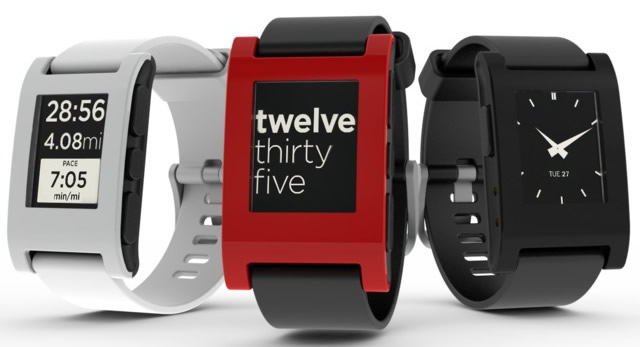Smartwatches and other wearable computers seem to be the biggest new category of 2013, taking the place of tablets just a few years before. These wrist-mounted computers have a small display for showing the time, and typically connect to a smartphone over Bluetooth in order to show incoming notifications like text messages or emails. Like smartphones and tablets, smartwatches can run their own apps that extend their functionality – we’ve seen apps that can record your exercise, show upcoming appointments, or even control a camera remotely.
Pretty much everyone is working on a smartwatch: Apple, Google, Intel and LG are all said to be working on one, while Samsung, Sony and Qualcomm have already announced or released one. So far smartwatch success from these industry giants hasn’t been assured – Sony have released two generations of their SmartWatch to decent reviews but poor sales, while Samsung have reported that they’ve shipped 800,000 Galaxy Gear units to retailers but faced rather poor reviews.

Where these giants have failed to make much of an impact, a much smaller company has perhaps seen the most demonstrable success – Pebble Technology, the makers of the Pebble smartwatch. The Pebble was one of the very first Kickstarter success stories, a crowd-funded effort that allowed a small company with a big dream to succeed. Indeed, the Pebble raised $10 million from nearly 70,000 backers in its Kickstarter campaign, and since then we’ve seen nearly 100,000 Pebble smartwatches sold.
The Pebble’s success is partly down to its unique design. A big part of this design is its e-ink display, like that of the Kindle or other e-readers. This kind of display is great for displaying static text and images (like the time and notifications) because it only uses battery power when the screen must be redrawn. Things like video and web browsing are a no-go on such a display, but you get a massive advantage in terms of battery life. While the Sony SmartWatch 2 or Galaxy Gear require recharging every one or two days, the Pebble can go a week between charges, which feels altogether more in keeping with what you’d expect from a traditional watch.

Pebble Technology have also spent a lot of time building up their own community of developers and enthusiasts, where the giants like Samsung and Sony have largely failed to do so. That’s reflected in the scale and scope of apps available for the Pebble, and this constitutes a big selling point for a truly extensible device. Both Android and iOS have also evolved to support developers on the Pebble, particularly with broader support for Bluetooth Low Energy on new Android devices and the recent iOS 7 update on iPhones that makes pushing notifications to the Pebble much easier.
Out of the three most successful smartwatches thus far – the Pebble, the Sony SmartWatch 2 and the Galaxy Gear – the Pebble is the one I feel best reflects the strengths and utility of a smartwatch with its e-ink display and correspondingly excellent battery life. While Apple and others are waiting in the wings to produce their ultimate smartwatches, right now the Pebble is at the top of the pile.
All three major smartwatches (and more besides) are available from Mobile Fun. For more information including pricing and availability, visit the links below:
- Pebble SmartWatch for iOS and Android – Jet Black
- Sony SmartWatch 2 for iOS and Android – Black Silicone
- Samsung Galaxy Gear Smartwatch – Black
- All smartwatches available at Mobile Fun
Do you think I’ve chosen correctly by selecting the Pebble as the best, or do you prefer an alternative? Let me know in the comments.